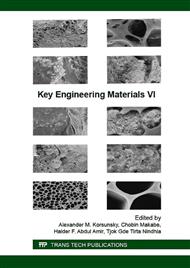p.35
p.40
p.45
p.50
p.57
p.63
p.68
p.72
p.77
Preparation and Properties of Solid Buoyancy Materials for Deep Sea with New Unsaturated Polyesters as Matrix
Abstract:
A solid buoyancy material (SBM) for deep sea was prepared with a new unsaturated polyester as the base resin, the hollow glass microspheres (HGM) as filler and some other additives. The new kind of unsaturated polyester resin (IPP-UP) was prepared with itaconic acid, isophthalic acid and propylene glycol as the raw materials, on the main chain of which the unsaturated double bonds exist as pendant groups. The hollow glass microspheres are purchased from 3M Company, USA, with the density of 0.42g/cm3 and compressive strength 55.2MPa. By adjust the amount of the hollow glass microspheres, samples of SBM for deep sea with different densities, water absorptions and compressive strengths were made. Studies have shown that, when the filling amount of HGM reaches 60% of the base resin system mass, the buoyant material exhibits excellent low density, low water absorption and high compressive strength which are 0.62g/cm3, 0.59% at 20°C for 24 hours and 67.5MPa.
Info:
Periodical:
Pages:
57-62
Citation:
Online since:
August 2016
Authors:
Price:
Сopyright:
© 2016 Trans Tech Publications Ltd. All Rights Reserved
Share:
Citation:


